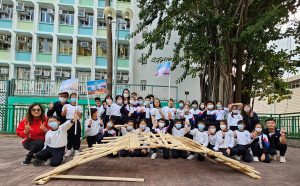In recent years, STEAM education has become increasingly popular, with many schools eager to design quality curricula that cultivate students' interdisciplinary knowledge and inspire creativity, collaboration, and logical problem-solving skills. In last year's Policy Address, the government mentioned a strong push for STEAM education at the primary and secondary school levels, incorporating more elements of innovative learning into the curriculum in a popular, engaging, and diverse manner. How can schools innovate and implement interesting teaching methods? SKH Holy Spirit Primary School attempts to integrate traditional Chinese culture and values education, constructing a unique school-based STEAM curriculum that allows students to learn interdisciplinary knowledge and understand Chinese culture in an engaging way.
Learning Activities Merging Chinese Culture
Last academic year, the school established a "STEAM Seed Group" with a focus on excellence, one of the activities being the "Dragon Boat Racing STEAM Activity" during the Dragon Boat Festival. This activity uses the festival's cultural significance as a starting point, combining interdisciplinary activities with values education to enhance students' understanding of Chinese culture. The activity begins with traditional Chinese stories to introduce the background of the Dragon Boat Festival and the traditions of dragon boat racing. The STEAM component incorporates design thinking, allowing students to create their own dragon boat designs and program remote control simulations using Micro:bit. Finally, music classes incorporate rhythm and performance teaching to mimic the context of dragon boat racing. The school's STEAM education director and General Studies subject chair, Mr. Ng, indicated that the curriculum incorporates Chinese culture and values, hoping students will gain a deeper understanding and appreciation for Chinese culture through these activities.

(The interviewed teacher, right: Mr. Ng Chin-hung.)
Promoting Hands-On Inquiry-Based Learning
Mr. Ng stated that teaching also aims to encourage students to engage in hands-on activities and trial-and-error experimentation, applying their interdisciplinary knowledge and enhancing problem-solving skills while connecting STEAM learning to real-life contexts. This approach strengthens the link between learning and life, thereby increasing students' interest and motivation in learning.
In addition to the elite activities, the school plans to implement school-wide interdisciplinary STEAM activities next academic year, encouraging students to participate in inquiry-based learning through hands-on strategies. For example, all fifth-grade students will participate in a "Chinese Bridge King" bridge-building activity that combines Chinese, mathematics, science, and visual arts knowledge around the theme. Students will first learn about traditional Chinese bridge-building wisdom and the Four Great Bridges of China in Chinese class, then attempt to create mini stone arch bridges using wood in General Studies, without any glue or tape.

(Students first conduct testing activities in the classroom, using their creativity to make things by hand.)
Following this, students will engage in practical bridge-building activities, constructing a sturdy two-meter-long bridge using wooden blocks. During this process, they will apply mathematical knowledge to measure the bridge's height and length while designing and testing the bridge's load capacity. Mr. Ng mentioned that students initially work in groups of ten to collaborate, which challenges their teamwork skills as they must coordinate and communicate to solve problems, and may even need to dismantle and reassemble.

(Through group collaboration, the students successfully worked together to build a wooden bridge.)
The school also promotes various other activities to complement the STEAM curriculum, including interdisciplinary theme learning days, where students conduct small experiments to enhance their scientific literacy; General Studies classes conduct annual STEAM lessons, where students engage in semi-open research activities, designing products to address real-life challenges. Through experimentation and active learning, students engage in interdisciplinary learning
SKH Holy Spirit Primary School is dedicated to cultivating students' interest and ability in science and technology, designing a curriculum that integrates traditional Chinese cultural values and practices interdisciplinary learning. While equipping students with 21st-century skills, the school actively responds to the broader trend of STEAM education. As an annual highlight in the education sector, the "Learning & Teaching Expo 2023" covers popular educational topics and the latest trends in education. The expo is currently seeking submissions and recruiting experienced educators to share insights, while teachers can also submit proposals to share valuable teaching experiences and insights with their peers.
